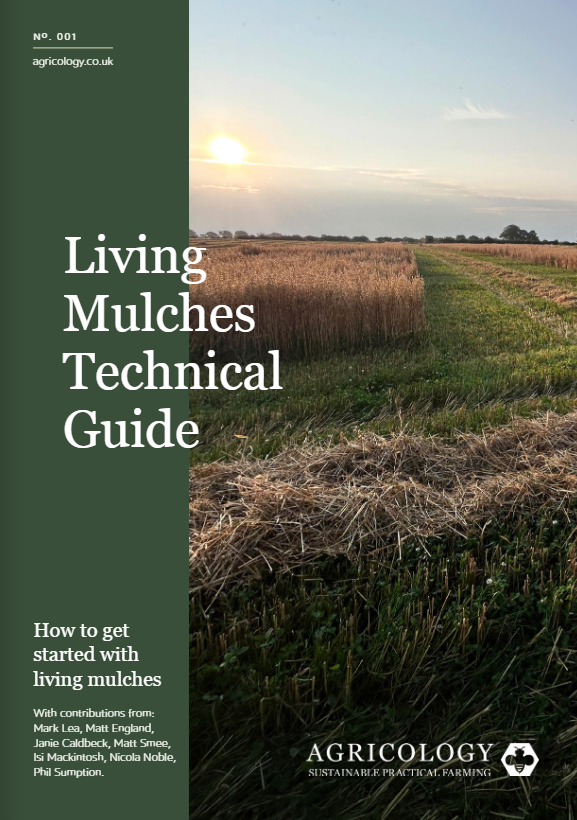Farmers looking to enhance soil health, increase resilience, and improve sustainability now have a powerful resource at their fingertips.
The newly released Agricology Living Mulches Technical Guide provides clear, practical advice on implementing living mulch strategies that deliver tangible benefits across farms of all sizes.
Living mulches are semi-permanent legume understories sown beneath cereal crops in the first year. By the second year, once the cover crop mulch is well established, new crops are direct drilled into it. This method integrates key regenerative agriculture practices, combining elements of intercropping, cover cropping, mulching, and undersowing to enhance soil health and improve biodiversity.
Co-created in response to farmers’ questions, the free-to-access guide builds on four years of research conducted through an Innovative Farmers Field Lab, further studies by the Organic Research Centre, and insights from UK farmers who have trialled living mulches. It is designed to offer clarity and step-by-step guidance on effectively adopting this innovative practice.

When managed effectively, living mulches can improve soil structure and fertility, reduce runoff and erosion, and enhance nitrogen availability for future crops. They can also boost in-field biodiversity, suppress annual weed populations, and lower production costs. However, without proper management, living mulches can also present challenges, including competition with crops, potential yield penalties, and increased perennial weed burdens.
Structured around the farming year, the guide focuses on the living mulch journey season by season – from spring establishment and summer field management, to harvest and autumn transition into a fully living mulch system and concluding with winter mulch management. Each seasonal chapter clearly outlines the actions required, important considerations and potential risks, providing a practical, time-based roadmap to help farmers plan, adapt and trial the system at their own pace.
It concludes with a detailed diary of Matt England’s observations and reflections from trialling living mulches on the Fring Estate in Norfolk over the course of three years.

While there are multiple ways to integrate living mulches, this guide focuses on a low-input system with alternative strategies and additional insights provided for those working within conventional farming systems.
Matt Smee, Head of Agricology at the Organic Research Centre, says that living mulches are a great tool for farmers seeking sustainable and efficient farming practices.
“Every farm is unique, every season brings new challenges, and no two years are the same. With this in mind, the guide provides a framework that allows farmers to tailor living mulch practices to suit their specific needs,” he says.
Along with the guide, an online learning journey exploring different approaches to getting started with living mulches has been created that you can find on the website in the form of the ‘Living Mulch Hub.’ It brings together a wide mix of resources; research papers, videos, tools, blogs and case studies, sourced from the Agricology archive and beyond.
To access the free online learning journey and the full Living Mulches Technical Guide, visit www.agricology.co.uk/resource/living-mulches-technical-guide/

Agricology (www.agricology.co.uk) is an independent knowledge platform that supports all farmers and growers in transitioning to more sustainable and resilient farming systems. It is a free platform open to everyone and was established in response to the increasing challenges of declining soil fertility, climate change, biodiversity loss, and the need to rethink the way land is managed. It brings together research from the field and farmer experiences on using practices that restore the farm ecosystem. These include reducing tillage to improve soil quality, planting cover crops, adding pollinator strips, using trap crops (which divert pests from crops instead of using chemicals), and using agroforestry systems.
Agricology was founded in 2015, is a collaboration between over 40 organisations, and is managed and delivered by the Organic Research Centre.
For more information contact Matt Smee on matt.s@organicresearchcentre.com


